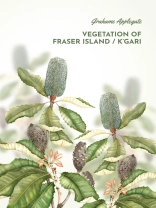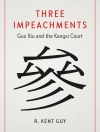Vegetation of Fraser Island / K’gari
Explore the vegetation communities of Fraser Island / K’gari with the aid of this self-guided driving and walking tour to 10 distinctive natural ecosystems on the largest sand island in the world. These vegetation communities contain over 850 flowering plants and ferns which have been compiled into a species list of scientific and common names and sorted into categories according to the vegetation type and sand dune formations in which they are found. Using this guide, the nature enthusiast can gain a snapshot of how the island was formed, some of the post-colonial history and forest management practices, to identify the different vegetation associations and the dune types on which they occur, which range from the beautiful heaths on the very old sand dunes on the west coast to the tall giant satinay trees in the protected valleys on the 300, 000 year old dunes in the centre of the island at Pile Valley. As you travel throughout the island and pass through the different vegetation types, often with sharply defined boundaries, this book of 160 pages will assist you to gain a better understanding of the vegetation on this natural wonder called Fraser Island / K’gari.
Spis treści
CONTENTS
Foreword
List of Figures
List of Tables
List of Photographs
Preface
LOCATION AND BIOPHYSICAL CHARACTERISTICS
Introduction
Location
Vegetation
Climate
Ground Water
Geology and Soils
Geomorphology
Dune Age
Deposition Units
Dune Units (Landscape Classification)
Physiographic Units
FLORISTIC ENVIRONMENT
General Relationships
Water Table and Vegetation
Topography and Vegetation
Geology – Sand Deposition – Physiography – Landscape
Soil Age – Depth of Leaching – Vegetation
Exposure and Proximity to the Ocean
Fire
Rare and Threatened Flora
Peat Swamps
VEGETATION ASSOCIATIONS
Vegetation and Physiography
Strand
Fore Dune
Hind Dune
High Dune
Littoral Flats
BIOMASS PRODUCTIVITY AND NUTRIENT STATUS OF THE FRASER ISLAND FORESTS
SELF GUIDED VEGETATION DISCOVERY TOUR
CHECK LIST OF PLANT SPECIES FOUND ON FRASER ISLAND / K’GARI
Index of Botanical and Common Names in Species Check List
GLOSSARY
ACKNOWLEDGEMENTS
REFERENCES
APPENDIX 1
A description of the BVGs found on Fraser Island (extract from Neldner et al. 2015)
O autorze
Grahame Applegate is an Associate Professor at the Tropical Forests and People Research Centre, University of the Sunshine Coast, Australia, with a Master of Natural Resources from University of New England and a Bachelor of Science (Forestry) from the Australian National University. He has forestry, natural resource management and research experience, working for over 35 years in tropical forest management, community forestry, smallholder forestry, peat fire and peatland restoration in the Asia-Pacific region.
As a young graduate, Grahame studied the ecology of the blackbutt forests which dominate a large part of Fraser Island/K’Gari which necessitated developing an understanding of the floristics and the preparation of a check list of the plant species, which became part of his dissertation. This work grew out of his first experience on the island at the age of 19 with the Queensland Forestry Department, undertaking some of the silvicultural practices in the same blackbutt forest, which a few years later would be the subject of his research and a further opportunity to learn more about the island and its diverse and stunning forests. Grahame continues to assist with ecological research in the rainforests of north Queensland with the University of the Sunshine Coast and in the tropical Peat Swamp Forests and peatlands in Indonesia.
Many years later after a career in tropical forestry research and consulting, he returned to the island and with the assistance of the Queensland Herbarium, updated his species list and included many of the weed species that had invaded the island and addressed species and family name changes that had occurred over the past few decades.
Grahame has long held a desire to publish his work on the island and share his fascination with the sand formations and vegetation to a wider audience. Solitary and seminal work on the carbon content of eucalyptus formed the solid base for his work on fire in later years. And the surfing was excellent!











